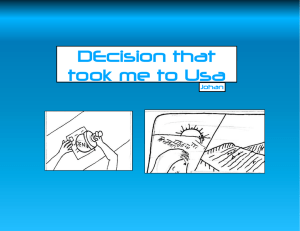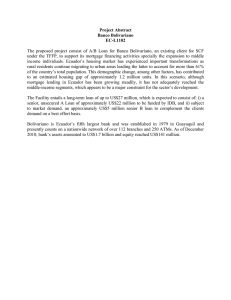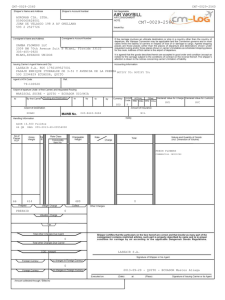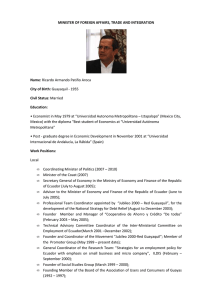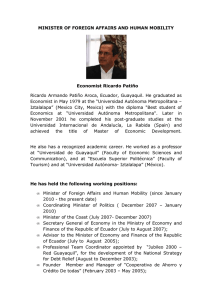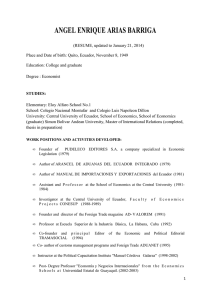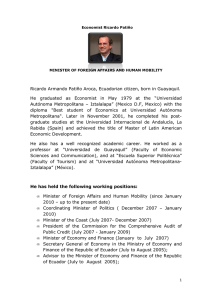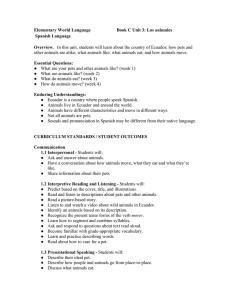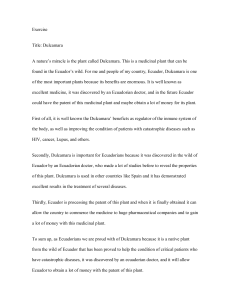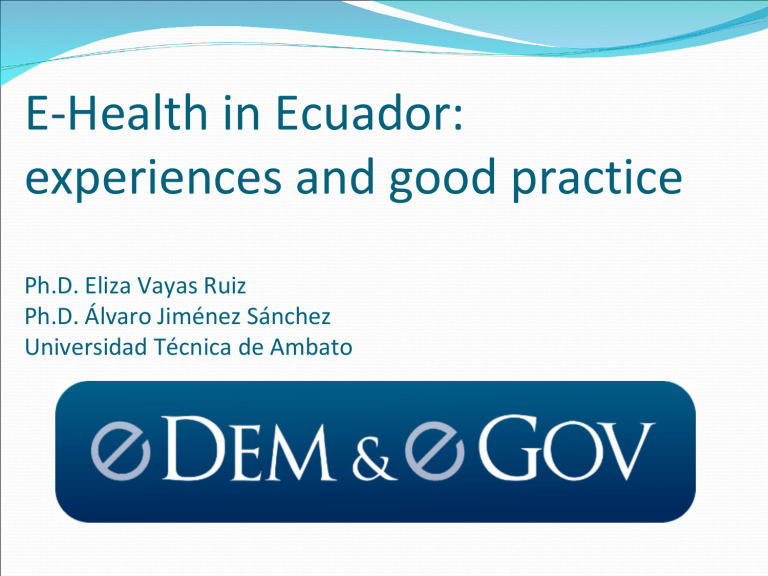
E-Health in Ecuador: experiences and good practice Ph.D. Eliza Vayas Ruiz Ph.D. Álvaro Jiménez Sánchez Universidad Técnica de Ambato Introduction World Health Organization (WHO): E-health is the cost-effective and secure use of information and communications technologies in support of health and health-related fields, including health-care services, health surveillance, health literature, and health education, knowledge and research. Introduction -It is wrong to think that online services constitute a legitimate way to treat disease. -They must not be considered a first port of call, but rather a complementary source of guidance. -Practices of E-health in Ecuador were examined (main sites). Methodology -Documentary literature review. -Content analysis. -16 websites and 3 social networking. -General characteristics were analyzed: *Organizations which host content. *Mission and basic aims. *Principal topics addressed. *Initiatives and campaigns which are carried out. *Services offered. *Administrative and other processes which are facilitated. Results -Two old concepts: – Telemedicine and Telehealth. • Telemedicine for isolated rural sectors in Ecuador. • Tutupaly project. -Since that time, several strategic objectives have been proposed: -Organizing hospital and outpatient medical services through remote communication systems -Facilitating health promotion and prevention initiatives, management, training, library services, and research, including intercultural considerations, through the integrated use of ICT at the national level -Establishing programs and projects aimed at virtual education and the interaction between family and community-based health professionals through the appropriate use of ICT -There are few educational initiatives which involve leading institutions and participants from the community. Results -Websites: 1-Portal of the Pan-American Health Organization (PAHO)-Ecuador - https://www.paho.org/ecu/ 2-Ministry of Public Health of Ecuador - https://www.salud.gob.ec/ 3-Virtual Campus of Public Health (Ecuador Node) - https://ecuador.campusvirtualsp.org/ 4-Medical Literature of Ecuador - https://www.redaccionmedica.ec/ 5-Virtual Health Library Ecuador (VHL-Ecu) - http://bvs-ecuador.bvsalud.org/ 6-Directory of Professionals and Medical Services of Ecuador (ECUAMEDICAL) - http://www.ecuamedical.com/ 7-Organization UNIVIDA -http://www.care.org.ec/univida/ Results -Websites: 8-Society for the Fight against Cancer in Ecuador (SOLCA) - https://www.solca.med.ec/ 9-Organization “Ecuadorian Coalition” (CEPVVS) - http://www.coalicionecuatoriana.org/ 10-VIHDA Foundation - http://www.vihda.org.ec/ 11-Corazones Valientes Foundation - http://www.fundacioncorazonesvalientes.org.ec/ 12-Living Association website - http://www.avivir.org/ 13-Vozandes Hospital Quito website - http://www.hospitalvozandes.com/ 14-Specialist Hospital “Eugenio Espejo” -http://hee.gob.ec/ Results -Websites: 15-Specialist Hospital of Guayaquil, “Dr. Abel Gilbert Pontón - https://www.hagp.gob.ec/ 16-Durán Hospital website (Ambato-Tungurahua) - http://hospitalduran.com/ -Social Networks -Facebook: SaludEcuador (175,577 followers) - https://facebook.com/SaludEcuador/ -Twitter: Salud_EC (272,000 followers) - https://twitter.com/salud_ec -YouTube: EcuadorSalud (1,707,665 views) - https://www.youtube.com/channel/UCX8r98_lwSQkya505vRXCVA Portal of the Pan-American Organization (PAHO)-Ecuador Health Ministry of Public Health of Ecuador Virtual Campus of Public Health (Ecuador Node) Website of Medical Literature of Ecuador Virtual Health Library Ecuador (VHL-Ecu) Directory of Professionals and Medical Services of Ecuador (ECUAMEDICAL) Website of the organization UNIVIDA Society for the Fight against Cancer in Ecuador Ecuadorian Coalition (CEPVVS) VIHDA Foundation Corazones Valientes Foundation Living Association website Vozandes Hospital Quito website Website of the Specialist Hospital, “Eugenio Espejo” Specialist Hospital of Guayaquil, “Dr. Abel Gilbert Pontón” Durán Hospital Website (Ambato-Tungurahua) Facebook: SaludEcuador Twitter: Salud_Ec YouTube: EcuadorSalud Opportunities offered: Digitalization of medical records and files Tele-consultations, ranging from feedback between health professionals in rural contexts to reports from specialists in the most developed medical centers Deferred consultations via email Tele-consultations through real-time videoconferencing applications Emergency tele-consultations established in real time (not programmed) Tele-consultations and tele-diagnoses in general Tele-medicine and tele-healthcare in general Radiology services Surgery (using smart digital theaters transmitting by videoconference from more developed hospitals for teaching and research purposes) Opportunities offered: The updating of studies on dermatology, cardiology and other specialities Monitoring and surveillance actions Scientific and technical information on health issues for use by the public (currently the most widespread application of E-health) Patient management and appointments services Tele-education in health, including practical training and the transmission of up-to-date information for professional training Academic research in the field of health The modernization of telecommunications networks Conclusions -Increase in the number of websites, social networking sites and mobile applications making a contribution to dynamic E-health practices. -However, the area of E-health has not been especially prioritized in Ecuador. -Most of the info-communication proposals for addressing healthcare through technology lack the necessary coordination and inter-sectorial participation of both medical centers and of academic organizations and public and private institutions. -Greater participation and collaboration are required. -Constant dialogue between specialists, and with the public, fosters credibility and awareness about published content and informs the decision-making process based on it. Suggestions a) Providing guidance on the implementation of healthpromotion and disease-prevention programs. b) Updating documentation on health education. c) Proposing and putting into effect management models in health promotion and disease prevention. d) Creating archives of experience at the local, regional and national level. e) Providing spaces for sharing pedagogical and didactic methodologies in health education and other aspects. THANK YOU
